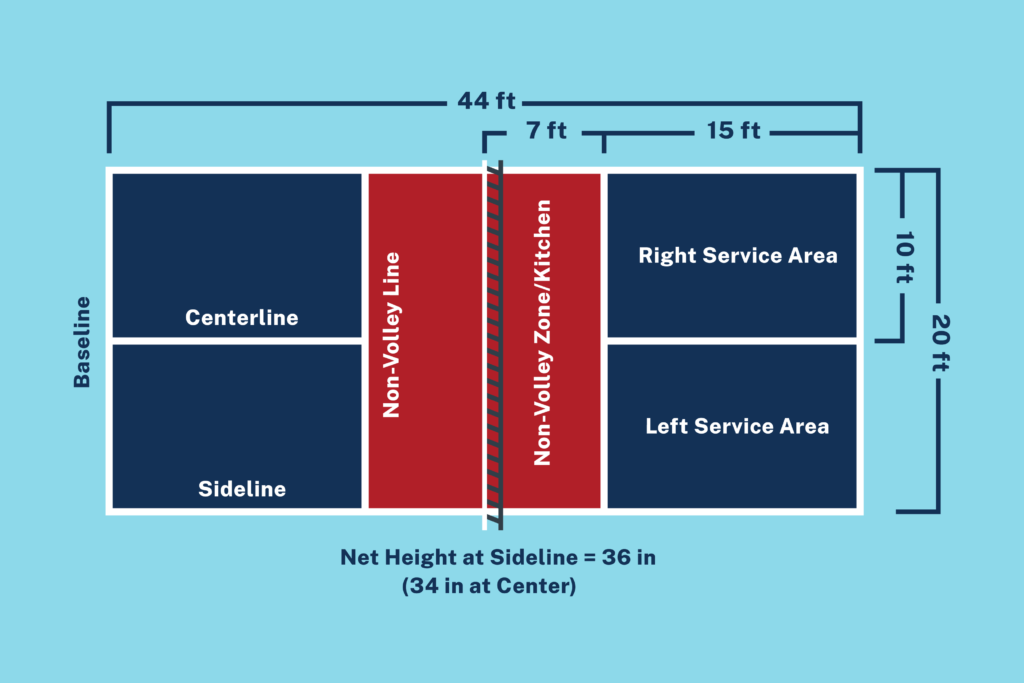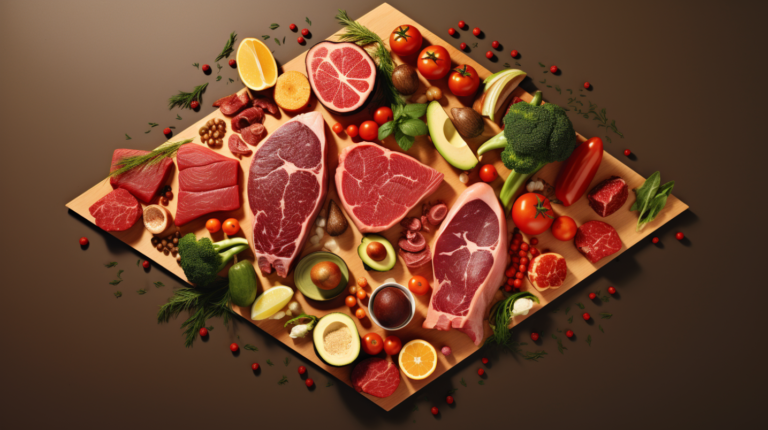Practice the Basics: A Beginner’s Comprehensive Guide on How to Play Pickleball
Welcome to the exciting world of pickleball! In this comprehensive guide, I will walk you through the basics of how to play this fun and engaging sport. Whether you’re a seasoned athlete or new to the game, pickleball offers a unique blend of strategy, teamwork, and athleticism that will keep you hooked.
Key Takeaways:
- Pickleball is an inexpensive and easy sport to learn, making it accessible to players of all ages and skill levels.
- Finding an experienced player to guide you is the most efficient way to get started, but beginner-friendly locations are also a great option.
- Investing in the right equipment, such as a paddle and suitable shoes, is essential for optimizing your performance on the court.
- Understanding the dimensions of the pickleball court and the basic rules of the game will ensure a seamless playing experience.
- Mastering pickleball shots and techniques, such as groundstrokes and volleys, is key to improving your gameplay and enjoying the sport to the fullest.
Now that you have an overview of what to expect in this comprehensive guide, it’s time to dive into the exciting world of pickleball. Let’s get started!
Finding a Pickleball Partner or Location
As a beginner, it is crucial to find a pickleball partner or a location that will allow you to practice and improve your skills. Pickleball is a social and collaborative sport, and having a partner to play with can make the learning process more enjoyable and effective. If you already know someone who plays pickleball, reach out to them and ask if they would be willing to teach you the ropes. Having an experienced player as your partner can help you learn the fundamental techniques and strategies of the game.
If you don’t know anyone who plays pickleball, don’t worry! There are plenty of beginner-friendly locations where you can find fellow enthusiasts looking for partners. Local community centers, recreational clubs, and sports facilities often offer pickleball courts and host regular games or meetups. You can check their schedules or inquire about beginner-friendly sessions. Joining a pickleball club or organization is also a great way to connect with other players and find partners or group activities.
In addition to finding a partner, it’s important to consider the location where you’ll be playing. Pickleball can be played either indoors or outdoors, and each has its own advantages and considerations. Indoor courts provide a controlled environment with consistent lighting and weather conditions, making it easier to focus on your game. Outdoor courts, on the other hand, offer a more natural environment and are often free to use. They provide fresh air and the opportunity to play under the sun, which can enhance your overall pickleball experience.
Whether you choose an indoor or outdoor location, make sure to check the availability of courts and any guidelines or regulations that need to be followed. Some facilities may require reservations, while others operate on a first-come, first-served basis. It’s always a good idea to familiarize yourself with the court rules and etiquette to ensure a smooth and enjoyable playing experience for yourself and others.
In summary, finding a pickleball partner or location is essential for beginners looking to improve their skills. Whether you connect with an experienced player or join a local community, having a partner to practice with can greatly enhance your learning experience. Consider both indoor and outdoor locations, and be sure to check court availability and regulations. So, grab your paddle, find a partner, and get ready to have a great time playing pickleball!
*This table provides a list of recommended pickleball locations in different cities across the United States:*
| City | Indoor Location | Outdoor Location |
|---|---|---|
| New York City | ABC Sports Club | Central Park Pickleball Courts |
| Los Angeles | LA Fitness | Griffith Park Pickleball Courts |
| Chicago | Sports Club Illinois | Grant Park Pickleball Courts |
| Miami | Miami Sports Center | South Pointe Park Pickleball Courts |
| Houston | Fit Club Houston | Eleanor Tinsley Park Pickleball Courts |
Remember to check the availability and regulations of each location before planning your visit. Enjoy your pickleball journey!
Selecting the Right Equipment for Pickleball
Let’s talk about the equipment you’ll need to get started with pickleball and how to choose the right gear for your game. Pickleball is a relatively inexpensive and easy sport to learn, and having the right equipment can greatly enhance your playing experience. The two essential pieces of equipment you’ll need are a pickleball paddle and suitable shoes.
When it comes to pickleball paddles, there are different materials and weights to consider. Composite paddles, made from a combination of fiberglass and polymer, are the most popular choice among players of all levels. They provide a good balance of power and control, making them ideal for beginners. Avoid wooden paddles, as they tend to be heavier and less responsive.
Weight is another important factor to consider when choosing a pickleball paddle. A paddle that is too light may lack power, while one that is too heavy can cause fatigue during long matches. It is recommended to choose a paddle that is between 6.5 oz and 9 oz in weight. This range offers a good balance of maneuverability and power. One paddle that comes highly recommended for beginners is the Paddletek Phoenix LTE. It offers a lightweight design, excellent control, and a comfortable grip, making it a great choice for players just starting out.
| Paddle Material | Weight | Recommended Choice for Beginners |
|---|---|---|
| Composite | 6.5 – 9 oz | Paddletek Phoenix LTE |
In addition to a paddle, you’ll also need suitable shoes for pickleball. Look for shoes that provide good support and traction on the court. Opt for shoes specifically designed for indoor or outdoor pickleball, depending on where you’ll be playing. Having the right shoes can help prevent injuries and improve your movement on the court.
Now that you have an understanding of the equipment needed for pickleball, it’s time to get out there and start playing. Remember, the right gear can make a significant difference in your performance and enjoyment of the game. So, choose wisely, and get ready to have a blast on the pickleball court!
Understanding Pickleball Court Dimensions and Rules
To play pickleball effectively, it’s important to understand the dimensions of the court and the rules that govern the game. Pickleball is played on a badminton-sized court, measuring 20 feet wide by 44 feet long for both singles and doubles play. The court is divided into different zones, each with its own purpose in the game.
The dimensions of a pickleball court are as follows:
| Zone | Dimensions |
|---|---|
| Baseline | 20 feet wide |
| Sideline | 44 feet long |
| Non-volley zone (kitchen) | 7 feet from the net on each side |
| Service area | 20 feet from the net on each side |
The kitchen is a crucial area in pickleball, where players are not allowed to hit volleys. This rule helps to prevent players from crowding the net and encourages strategic gameplay. It’s important to stay out of the kitchen unless the ball has bounced once on each side of the net, allowing for a volley to be played.
To help you visualize the court dimensions, here is a eagle-eyed view of a pickleball court:

Now that you have a clear understanding of the court dimensions and zones, let’s dive into the rules of pickleball. The game starts with a serve, which must be hit with an underhand stroke or backhand and clear the kitchen. If the serve does not clear the kitchen or lands out of bounds, it is considered a fault. The serving team continues to serve until they lose a rally, at which point the serve switches to the opposing team.
Points are earned when the opposing team fails to return the ball successfully, hits a shot out of bounds, or commits a fault. The game is won by the first team to reach 11 points, with a 2-point lead required to win. In singles play, the rules are slightly different, but the overall objective remains the same.
Understanding the dimensions of the court and the rules of pickleball is essential for beginners looking to improve their skills and enjoy the game to its fullest. Now that you have a solid foundation, it’s time to move on to the next section and master the various shots and techniques in pickleball!
Mastering Pickleball Shots and Techniques
Now that you have a good grasp of the rules, let’s focus on mastering the different shots and techniques used in pickleball. Developing a strong skill set in these areas will greatly improve your gameplay and give you a competitive edge on the court.
Groundstrokes
Groundstrokes are shots played after the ball has bounced on your side of the court. These shots are typically hit from the baseline and are used to control the tempo of the game. To execute a groundstroke, keep your eye on the ball and position yourself to hit the ball waist-high or higher. Use your arm and wrist to generate power, and aim to hit the ball with topspin to keep it in play. Practice hitting both forehand and backhand groundstrokes to become proficient in all areas of the court.
Volleys
Volleys are shots played in the air, before the ball bounces on your side of the court. These shots are often hit near the kitchen line and require quick reflexes and good hand-eye coordination. When hitting a volley, keep your grip firm but relaxed, and use a short punching motion to make contact with the ball. Aim to hit the ball with precision and control, placing it strategically away from your opponents. Practice volleys from different positions on the court to improve your reaction time and placement.
The Non-Volley Zone
The non-volley zone, also known as the “kitchen,” is a 7 ft area near the net where players are not allowed to hit volleys. This zone is designed to prevent players from dominating the game with powerful smashes. When approaching the kitchen, focus on hitting soft shots that clear the net and land deep in your opponent’s court. Mastering the art of playing from the non-volley zone will give you an advantage in controlling the game and setting up winning shots.
By practicing and honing your groundstrokes, volleys, and understanding the dynamics of the non-volley zone, you’ll be well on your way to becoming a skilled pickleball player. Remember to stay focused, practice regularly, and most importantly, have fun on the court!
| Shot Type | Description |
|---|---|
| Groundstrokes | Shots played after the ball has bounced on your side of the court. Used to control the tempo of the game. |
| Volleys | Shots played in the air, before the ball bounces on your side of the court. Requires quick reflexes and hand-eye coordination. |
| Non-Volley Zone (Kitchen) | A 7 ft area near the net where players are not allowed to hit volleys. Focus on hitting soft shots that clear the net and land deep in your opponent’s court. |
Strategies and Tips for Winning Pickleball Games
To become a successful pickleball player, it’s essential to develop effective strategies and employ smart gameplay tactics. While mastering the basic shots and techniques is important, having a solid game plan can give you a competitive edge on the pickleball court. Here are some strategies and tips to help elevate your gameplay:
1. Communication and Positioning
One key aspect of pickleball is effective communication with your partner. Constantly communicate with your partner to decide who will hit the ball, where to position yourself on the court, and who will cover certain areas. Strong communication can help prevent confusion and lead to better coordination, allowing you to anticipate and react to your opponent’s shots more effectively.
In addition to communication, positioning yourself strategically on the court is crucial. Try to maintain a balanced court coverage, making sure to protect the middle and sidelines. By positioning yourself well, you can limit your opponent’s shot options and create opportunities for offensive play.
2. Shot Selection
Understanding when to use different shots is another key aspect of a winning strategy. While pickleball offers a wide range of shot options, it’s important to choose wisely based on the situation. For example, if you’re playing close to the non-volley zone or “kitchen,” quick reflex volleys and dinks can be effective. On the other hand, when the ball is hit to the back of the court, using groundstrokes can help you regain control of the game.
Remember to vary your shot selection to keep your opponents guessing and off-balance. A mix of soft shots, hard shots, and lobs can help you create confusion and force errors from your opponents.
3. Practice, Practice, Practice
One of the best ways to improve your gameplay and implement effective strategies is through regular practice. Take the time to work on different shots, practice drills that simulate game situations, and refine your footwork. By dedicating yourself to practice, you’ll develop muscle memory, improve your reaction time, and enhance your overall pickleball skills.
Lastly, don’t forget to have fun! Pickleball is a game that brings joy and camaraderie. Enjoy the process of learning, making mistakes, and improving. Embrace the challenges, stay positive, and always strive to be a better player each time you step onto the court.
| Strategy | Tips |
|---|---|
| Communication and Positioning | – Constantly communicate with your partner – Position yourself strategically on the court |
| Shot Selection | – Vary your shots – Adapt your shot selection to the situation |
| Practice | – Regularly practice different shots and drills – Focus on refining footwork and reaction time |
Pickleball Scoring and Serving Rules
Understanding the scoring system and serving rules is essential to navigate your way through pickleball matches successfully. The game is played to 11 points, and a team must have a 2-point lead to win. Let’s take a closer look at how the scoring works in pickleball.
In pickleball, points can only be scored when the serving team is serving. If the receiving team wins a rally, they do not earn a point but gain the opportunity to serve. The serving team continues to serve until they lose a rally, at which point the serve is handed over to the opposing team.
It’s important to note that the serving team must always serve from the right-hand side of the court. The serve must be hit with an underhand stroke or backhand and must clear the kitchen, which is the non-volley zone that spans 7 feet from the net. If the serve does not clear the kitchen or goes out of bounds, it results in a fault.
Double Bounce Rule
An important rule to understand is the double bounce rule. This rule states that the ball must bounce once on each side before volleys (hitting the ball in the air without letting it bounce) can be hit. This ensures fair play and gives both teams a chance to return the ball.
| Scoring | Serving Team | Receiving Team |
|---|---|---|
| 0-0 | 0 | 0 |
| 1-0 | 1 | 0 |
| 1-1 | 1 | 1 |
| 2-1 | 2 | 1 |
To win a rally, the ball must be hit within the boundaries of the court. If a shot goes out of bounds or hits into the net, it results in a fault, and the opposing team gains a point. The rotation of serving in doubles play ensures that both players on a team get the opportunity to serve.
Now that you have a better understanding of the scoring system and serving rules in pickleball, you can confidently step onto the court and enjoy the game. Remember to practice your serves and be aware of the double bounce rule to maximize your chances of success. Happy pickleball playing!
Practicing Pickleball Drills to Improve Skills
The key to becoming a skilled pickleball player is through consistent practice and engaging in various drills that target specific skills. By incorporating regular drills into your training routine, you can improve your technique, accuracy, and overall performance on the court. Here are some beginner-friendly pickleball drills to help you enhance your skills:
- Groundstroke Drill: This drill focuses on developing your groundstroke technique. Stand on one side of the court and practice hitting the ball back and forth with a partner, focusing on keeping the ball low and within the bounds of the court. This drill will help you improve your control and consistency.
- Volleys and Dinks Drill: This drill is designed to improve your volleys and dinks, which are crucial shots in pickleball. Stand in the non-volley zone and have your partner hit balls to you. Practice returning the shots with volleys and dinks, aiming to keep the ball low and controlled. This drill will help you master your net play and improve your touch at the kitchen line.
- Serve and Return Drill: This drill focuses on your serving and returning skills. Practice serving the ball to specific areas of the court and then practice returning those serves with accuracy. This drill will help you develop consistency in your serves and improve your ability to handle different types of serves.
- Footwork Drill: Good footwork is essential in pickleball to quickly move around the court and position yourself for shots. Set up cones or markers on the court and practice moving around them in different patterns. Focus on maintaining balance, agility, and quickness. This drill will help improve your footwork and enhance your overall court coverage.
Table: Recommended Beginner-Friendly Pickleball Drills
| Drill | Objective |
|---|---|
| Groundstroke Drill | Improve control and consistency in groundstrokes |
| Volleys and Dinks Drill | Enhance net play skills and touch at the kitchen line |
| Serve and Return Drill | Develop consistent serving and returning abilities |
| Footwork Drill | Improve footwork, balance, agility, and quickness |
Remember, the key to improving your pickleball skills is to practice regularly and focus on specific drills that target different aspects of the game. By incorporating these drills into your training routine, you’ll be well on your way to becoming a skilled pickleball player!
Congratulations on completing this comprehensive guide on how to play pickleball!
Pickleball is a relatively inexpensive and easy sport to learn, making it a great choice for beginners. Now that you have all the necessary information, you can confidently step onto the court and start enjoying this exciting game.
One of the most efficient ways to get started in pickleball is to find someone experienced who can teach you the ropes. If you don’t know anyone who plays, don’t worry! There are plenty of beginner-friendly locations where you can join in and learn from others who are just starting out, too.
When it comes to equipment, the basic essentials include a paddle and suitable shoes. The paddle is an important tool in pickleball, and there are different materials and weights to choose from. Composite paddles are the most popular choice among beginners, and it is recommended to avoid wooden paddles. Aim for a paddle that weighs between 6.5 oz and 9 oz. The Paddletek Phoenix LTE is a highly recommended paddle for beginners.
Now that you have a partner, the right equipment, and understanding of the rules, it’s time to hit the court and practice your shots and techniques. Remember, there are two main types of shots in pickleball: groundstrokes and volleys. Each requires different techniques and strategies for success. Additionally, be aware of the non-volley zone, also known as the “kitchen,” where you cannot hit volleys from.
By practicing pickleball drills, you can improve your skills and enhance your gameplay. Whether it’s working on your serves, volleys, or groundstrokes, consistent practice will help you become a better player. Don’t be afraid to experiment with different strategies and shot selections to find what works best for you.
With an understanding of the scoring and serving rules, you’ll be able to confidently play pickleball matches. Keep in mind the double bounce rule, where the ball must bounce once on each side before volleys can be hit. In doubles play, both players on a team get the opportunity to serve, and the serving team continues serving until they lose a rally. The game is won by the first team to reach 11 points, with a 2-point lead required to win. If you prefer singles play, there are slight rule differences to be aware of.
Congratulations once again on completing this comprehensive guide on how to play pickleball! Armed with this knowledge, passion, and enthusiasm, you’re ready to dive into the world of pickleball and enjoy the countless hours of fun and friendly competition that await you on the court.
FAQ
How can I find someone to play pickleball with?
If you don’t know anyone who plays pickleball, try looking for beginner-friendly locations in your area where you can join and meet other players.
What equipment do I need to play pickleball?
Basic equipment for pickleball includes a paddle and suitable shoes. Look for composite paddles weighing between 6.5 oz and 9 oz for optimal performance.
What are the dimensions of a pickleball court?
A pickleball court is the size of a badminton court, with a net height of 36′ at the sideline and 34′ at the center.
What are the different shots in pickleball?
There are two main types of shots in pickleball: groundstrokes and volleys. Groundstrokes are shots hit after the ball bounces, while volleys are hit without letting the ball bounce, but they must be executed outside the non-volley zone.
How do I score points in pickleball?
In pickleball, points are earned when the serving team wins a rally. The game is won by the first team to reach 11 points, with a 2-point lead required to win.
How can I improve my pickleball skills?
Practice pickleball drills to improve your skills. Work on your groundstrokes, volleys, and strategies to enhance your overall gameplay and proficiency.
What happens if I hit the ball into the net or out of bounds?
Hitting the ball into the net or out of bounds results in a fault. The opposing team then earns a point, and the serve rotates to the other team.
Can pickleball be played in singles?
Yes, pickleball can be played in singles. However, there are slight rule differences compared to doubles play.
Source Links
- https://www.pickleheads.com/blog/how-to-play-pickleball
- https://pickleballkitchen.com/get-started-pickleball-beginners-guide/
- https://joyridebookshop.indielite.org/book/9781088063668








